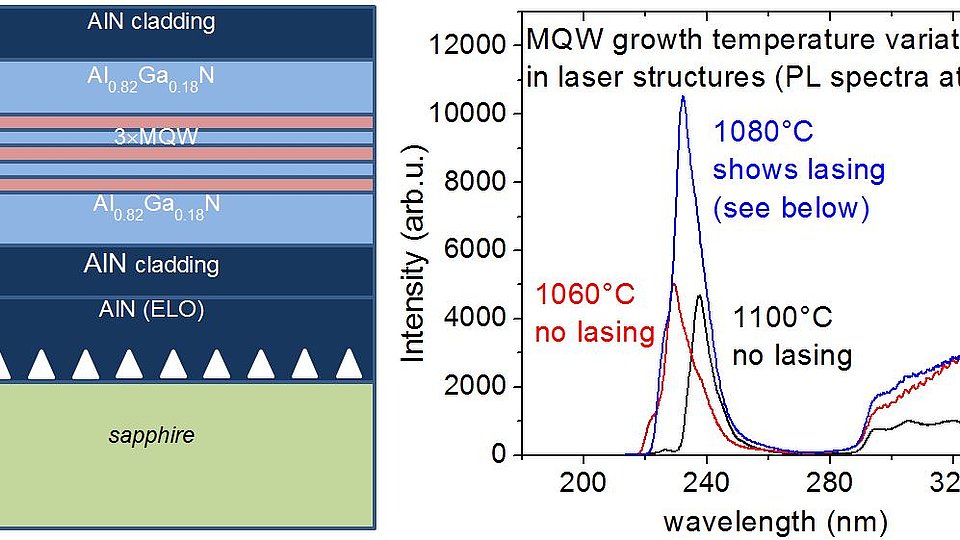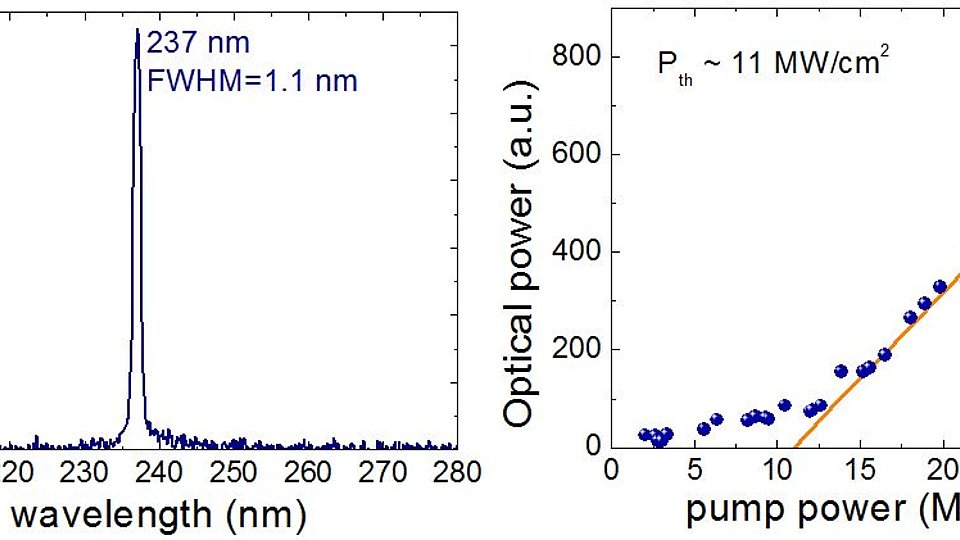AlGaN-based semiconductor laser with emission in the deep ultraviolet spectral region
Fig. 1: (l.) Typical layer structure of a UV laser, (r.) photoluminescence spectra of AlGaN quantum wells epitaxially grown at different temperatures - laser emission under optical pumping only at optimized growth temperature.
Compact semiconductor laser emitting in the ultraviolet (UV) spectral region, preferentially in the wavelength range ≤ 280 nm (UV-C), can be used for medical diagnostics, material processing, detection of biological agents, high-density data storage, and high resolution printing. However, the realization of such lasers based on the material system AlGaN is a challenge for many reasons. On the one hand, quantum wells with a high internal efficiency for radiative recombination of carries have to be fabricated, which is difficult due to the high density of dislocations in the range 109-1010 cm-2 for conventional epitaxial growth on sapphire substrates. On the other hand, a sufficiently high conductivity in AlGaN with a large aluminum mole fraction has to be obtained both for the p-side and the n-side of the diode. In the framework of the Joint Lab GaN Optoelectronics, FBH in collaboration with TU Berlin has succeeded in fabricating AlGaN heterostructures which show laser emission down to 237 nm under optical pumping. This number is the shortest wavelength ever reported for this material.
The fabrication of layer structures with low dislocation densities was the precondition for this success. Either the process of epitaxial lateral overgrowth (ELO) of AlN on sapphire substrates established at FBH or the homoepitaxy on high-quality AlN bulk crystals from the Institut für Kristallzüchtung (IKZ) in Berlin were used. In this way, smooth and crack-free layer systems with dislocation densities in the range 108 cm-2 or even orders of magnitude below were realized. Moreover, AlGaN/AlGaN multiquantum wells were optimized with regard to interface roughness and composition uniformity. E.g. macro-steps were observed on the surface of ELO AlN layers resulting from the coalescence process which support lateral variations in the composition of AlGaN layers. Fig. 1 shows that the growth temperature had to be carefully adjusted to fabricate structures which are capable of showing laser emission. Wafers with optimized layer structures were cleaved in bars of varying width (0.6 to 1.4 mm) und optically pumped from the epitaxial side using an ArF-excimer laser. Fig. 2 shows the emission spectrum and the power characteristics of the laser structure with the shortest emission wavelength at 237 nm. Currently, doped laser structures are studied to realize an UV-C semiconductor laser under current injection which has not been demonstrated up to now.
Publications:
M. Martens, F. Mehnke, C. Kuhn, C. Reich, V. Kueller, A. Knauer, C. Netzel, C. Hartmann, J. Wollweber, J. Rass, T. Wernicke, M. Bickermann, M. Weyers, and M. Kneissl, "Performance Characteristics of UV-C AlGaN-Based Lasers Grown on Sapphire and Bulk AlN Substrates", IEEE Photonics Technol. Lett., vol. 26, no. 4, pp. 342-345 (2014).
V. Kueller, A. Knauer, U. Zeimer, M. Kneissl, M. Weyers, "Controlled coalescence of MOVPE grown AlN during lateral overgrowth", J. Cryst. Growth, vol. 368, pp. 83-86 (2013).
FBH research: 04.06.2014

